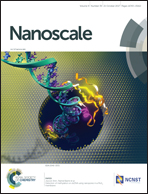Healable and flexible transparent heaters†
Abstract
Challenges associated with the mechanical fracture of electrical conductors have hindered the realization of truly flexible high performance wearable electronics. Here, transparent healable electrodes have been developed and examined to alleviate these problems. The composite electrode features a layer of an interconnecting AgNW network on a polyurethane film modified with Diels–Alder adducts (PU-DA). Surface modification using hydrophilic molecules improved adhesion of the AgNW network and resulted in mechanically robust flexible electrodes with a figure of merit sheet resistance of 13.3 Ω □−1 and 77% transmittance at 550 nm. Transparent and flexible healable heaters (TFHH) with good mechanical and thermal stability were fabricated using these electrodes for potential applications in thermochromics, electrically driven displays and defrosters. The PU-DA TFHHs exhibited high Joule heating temperatures of 102 °C with a low operation voltage (6 V), fast thermal response (150 s) and enhanced robustness to endure large repeated mechanical strain for over 500 bending cycles with a small variance in resistance (<10%). After deliberate damage by a knife cut, the electrodes were healed and recovered to their original conductivity via a simple heat treatment at 120 °C. Uniquely, the healing process can also be triggered by utilising electrical power.



 Please wait while we load your content...
Please wait while we load your content...